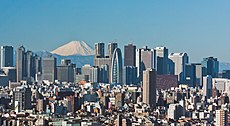
Back مدينة كبيرة Arabic بویوک شهر AZB অতিমহানগরী Bengali/Bangla Megagrad BS Megaby Danish Megastadt German Megasûke DIQ Megaciudad Spanish کلانشهر FA Megakaupunki Finnish
| Ekistics |
|---|
 |
|
|
A megacity is a very large city, typically with a population of more than 10 million people.[1][2][3][4] The United Nations Department of Economic and Social Affairs in its 2018 "World Urbanization Prospects" report defines megacities as urban agglomerations with over 10 million inhabitants.[5] A University of Bonn report holds that they are "usually defined as metropolitan areas with a total population of 10 million or more people".[6] Elsewhere in other sources, from five to eight million is considered the minimum threshold, alongside a population density of at least 2,000 per square kilometre.[7] The terms conurbation, metropolis, and metroplex are also applied to the latter.[7]
The total number of megacities in the world varies between different sources: The world had 33 according to the UN (in 2018), 45 according to CityPopulation.de (in 2023), and 44 according to Demographia (in 2023). About half of these urban agglomerations are in China and India. The other four countries with more than one megacity are Brazil, Japan, Pakistan, and the United States. African megacities are present in Nigeria, Egypt, South Africa, and the DRC; European megacities are present in Russia, France, the United Kingdom, and Turkey (also in Asia); megacities can be found in Latin America in the countries of Brazil, Mexico, Colombia, Peru, and Argentina. Some sources identify Tokyo's Greater Tokyo Area as the largest megacity in the world,[5][8] while some others give the title to the Pearl River Delta in China.[9][10][11]
- ^ "Definition of megacity in English". Oxford Dictionaries. Archived from the original on March 27, 2018. Retrieved 27 March 2018.
- ^ "megacity meaning". Cambridge English Dictionary. Retrieved 27 March 2018.
- ^ Safarik, Daniel; Ursini, Shawn; Wood, Antony (2018). "Megacities and tall buildings: symbiosis". E3S Web of Conferences. 33: 01001. Bibcode:2018E3SWC..3301001S. doi:10.1051/e3sconf/20183301001.
- ^ Yeung, Y. -M.; Shen, Jianfa; Kee, Gordon (2020). "Megacities". International Encyclopedia of Human Geography (Second Edition): 31–38. doi:10.1016/B978-0-08-102295-5.10284-7. ISBN 9780081022962. S2CID 241912815.
- ^ a b Cite error: The named reference
UrbanizationProspects2018was invoked but never defined (see the help page). - ^ Kötter, Theo; Friesecke, Frank (1 March 2009). "Developing urban Indicators for Managing Mega Cities". World Bank. University of Bonn.
- ^ a b "Land Use and Land Use Change". seos-project.eu. Retrieved March 26, 2018.
- ^ Cite error: The named reference
Demographiawas invoked but never defined (see the help page). - ^ Cite error: The named reference
citypopulationwas invoked but never defined (see the help page). - ^ Van Mead, Nick (January 28, 2015). "China's Pearl River Delta overtakes Tokyo as world's largest megacity". The Guardian. Retrieved April 3, 2020.
- ^ Weller, Chris (July 8, 2015). "The world's largest megacity already has more people than Canada, Argentina, or Australia". Business Insider. Retrieved April 3, 2020.